Physical Address
304 North Cardinal St.
Dorchester Center, MA 02124
Ultrasound of the kidneys and bladder is the first-line imaging modality for most suspected anomalies of the urinary tract. Renal ultrasound (US) is usually performed with the patient in both the supine and prone positions. Transverse and longitudinal images are obtained of the kidney and bladder. The kidneys can be measured in both the prone and supine positions, and although measurements obtained with the patient in the prone position are more reproducible, they tend to underestimate the actual length. It is important to compare the patient's renal length with tables that plot normal renal length against age. The left and right kidneys should normally be within 1 cm of each other in length. If there is a discrepancy of more than 1 cm, an underlying abnormality should be suspected. A size discrepancy may result from a disorder that causes one of the kidneys to be too small, such as global scarring, or from a process that causes one of the kidneys to be too large, such as acute pyelonephritis or renal duplication.
The kidneys of infants have several characteristics that are different from those of older children and adults. They commonly and normally have an undulating contour secondary to persistent fetal lobulation ( Fig. 6-1 ). The renal cortex is more echogenic than in older children and can be isoechoic or hyperechoic to adjacent liver parenchyma. Moreover, in this age range, the renal pyramids are prominent in size ( Fig. 6-1 ), and due to their hypoechoic nature in contrast to the more echogenic renal cortex, the pyramids can be mistaken for cysts or dilation of the collecting system.
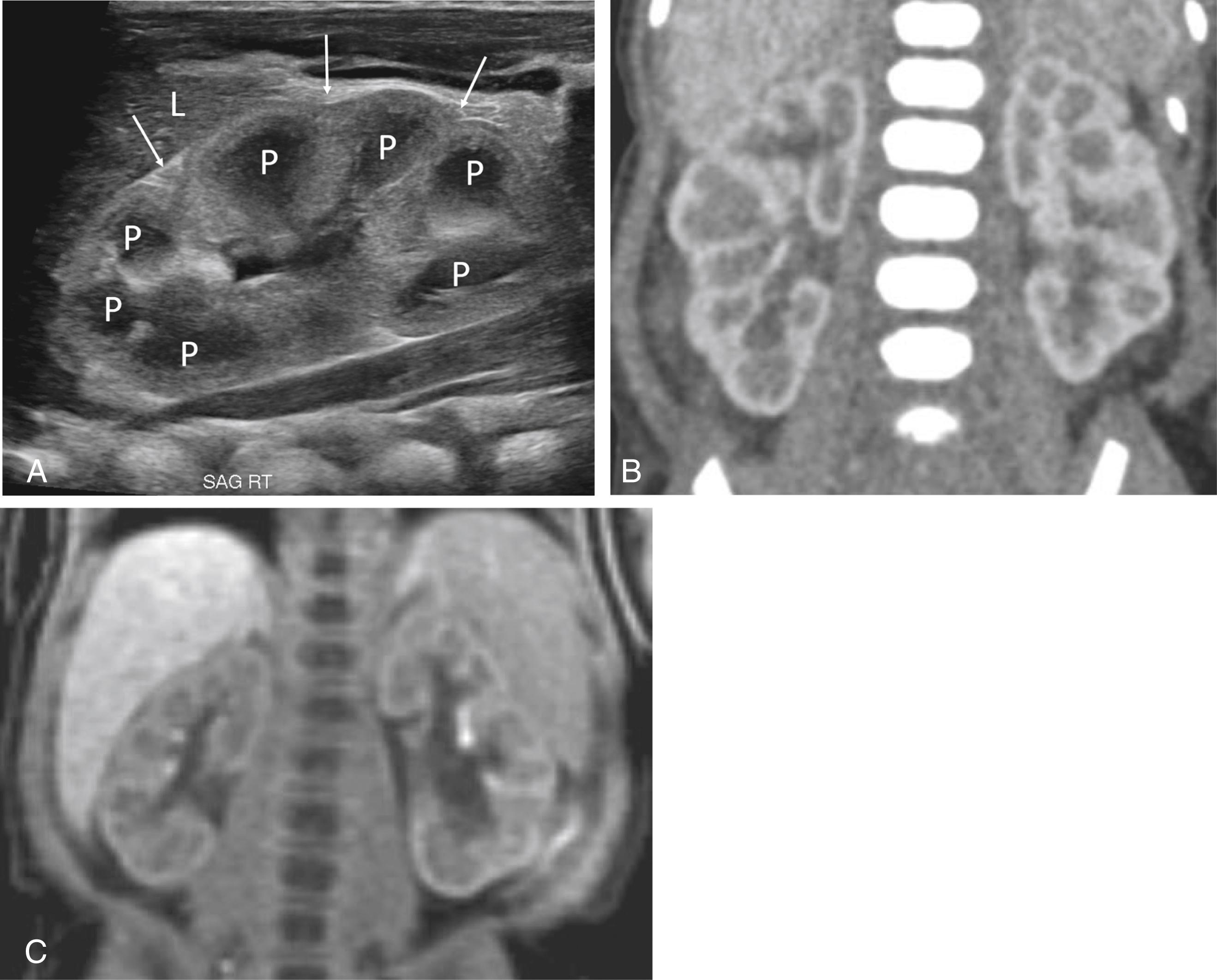
The most common indication for a fluoroscopic voiding cystourethrogram (VCUG) is the evaluation of urinary tract infection (UTI). Other indications include voiding dysfunction, enuresis, and the work-up for hydronephrosis. VCUG can demonstrate the presence or absence of vesicoureteral reflux (VUR) and can also document anatomic abnormalities of the bladder and urethra. VCUG is performed under fluoroscopy with the patient awake. Alternatively and increasingly more commonly, ultrasound-guided VCUGs with the use of an US contrast (microbubble) agent are being performed, instead of with fluoroscopic guidance thus avoiding the radiation. Regardless of the imaging modality, the patient is catheterized under sterile conditions, typically using an 8F catheter. For fluoroscopic guidance, a precontrast scout view of the abdomen can be obtained to evaluate for calcifications, document the bowel pattern so that it is not later mistaken for VUR, and confirm the catheter position within the bladder. Contrast is then instilled into the bladder. An early filling view of the bladder should be obtained to exclude a ureterocele. Once the patient's bladder is full, bilateral oblique views are obtained to visualize the regions of the ureterovesical junctions and the expected path of the ureters to document VUR. During voiding, the male urethra is optimally imaged with the patient in the oblique projection. The female urethra is best seen on the anteroposterior view. It is critical to obtain an image of the urethra during voiding, particularly in males. Voiding images can be obtained with the catheter in the urethra as its presence does not prevent the diagnosis of posterior urethral valves. After the patient has completed voiding, images are obtained of the pelvis and over the kidneys, documenting the presence or absence of VUR and evaluating the extent of postvoid residual contrast within the bladder and renal collecting systems. The use of fluoroscopy should be brief and intermittent during bladder filling. Fluoroscopic last-image hold images can often substitute for true exposures to further decrease radiation dose.
Sometimes, particularly in older children, it may be difficult to get the child to void on the table. Almost all children will eventually void, and a great deal of patience is required during such prolonged examinations. There are several maneuvers that may help the child to void. They include placing warm water on the patient's perineum or toes; placing a warm washcloth on the patient's lower abdomen; tilting the table so that the head is up; letting the patient hear the sound of running water in the sink; and dimming the lights.
The expected bladder capacity of small children can be calculated by adding two to the patient's age in years and multiplying that number by 30. This yields the bladder capacity in milliliters. Obviously, this formula works only up to a certain age.
Technetium-99m-mercaptoacetyltriglycine ( C MAG3) and Technetium-99m-dimercaptosuccinic acid ( 99 m Tc-DMSA) renal scintigraphic examinations are commonly used in children. Owing to its primary active tubular excretion, C MAG3 is generally used in suspected urinary tract obstruction generally with a diuretic (furosemide) challenge. 99 m Tc-DMSA is most reliable to evaluate relative renal function and is used to demonstrate cortical defects in infection, infarction, and scarring.
Magnetic resonance urography (MRU) has been increasingly used because of its superb delineation of the anatomy as a result of its intrinsic, high soft-tissue contrast resolution and multiplanar three-dimensional reconstruction capabilities. MRU is considered a “one-stop shop” examination because it can provide both anatomical and functional information in one examination without the use of ionizing radiation. MRU plays an important role in the evaluation of atypical urinary tract dilation, ureteral ectopia and genital anomalies. However, the widespread use of MRU is limited by its cost, availability, and the need for sedation.
UTI is the most common medical problem of the genitourinary system in children. The incidence of UTI is higher in girls than in boys, probably because of the short length of the female urethra. There is ongoing controversy with regard to when children with UTI should be imaged. The immediate goals of imaging children with UTI include the diagnosis of predisposing underlying congenital anomalies, identifying VUR, documenting any renal cortical damage, providing a baseline renal size for subsequent evaluation of renal growth, and establishing prognostic factors. The long-term goal is to eliminate the chance of renal damage leading to chronic renal disease and hypertension.
The American Association of Pediatrics recommends that the work-up of an infant with a first febrile UTI should include a renal and bladder ultrasound. Routine use of fluoroscopic or ultrasound-guided VCUG after a first febrile UTI is no longer recommended. VCUG should be obtained only if (1) US shows urinary tract dilation, scarring, obstructive uropathy, or masses; (2) any complex medical condition is associated with the UTI; (3) there are findings that suggest high-grade VUR or obstructive uropathy; or (4) there is a recurrence of febrile UTI. VCUG can be performed using fluoroscopy or ultrasound.
There is some confusion concerning the terminology used for infections of the urinary tract in children. The definition of UTI is the presence of bacteria in the urine, but the term typically refers to infections of the lower urinary tract. Acute pyelonephritis is defined as UTI that involves the kidney. Young children may present with nonspecific symptoms, such as fever, irritability, and vague abdominal pain. In older children, the findings may be more specific, such as fever associated with flank pain. In patients in whom the diagnosis is straightforward, no imaging is needed during the acute infection. US with color Doppler is probably now the most common way that pyelonephritis is imaged and shows lack of color flow in peripheral portions of the kidney. Cortical scintigraphy using 99 m Tc-DMSA has been advocated as being the most sensitive test for the diagnosis of pyelonephritis, showing single or multiple areas of lack of renal uptake of the radiotracer. These areas tend to be triangular and peripheral ( Figs. 6-2 and 6-3 ). Other imaging studies that can be used to detect acute pyelonephritis include contrast-enhanced computed tomography (CT) or magnetic resonance imaging (MRI). These studies typically demonstrate lack of contrast enhancement of triangular, peripheral portions of the kidney ( Figs. 6-3 and 6-4 ). CT may also show a striated nephrogram. In addition, pyelonephritis can be very focal and mimic a mass on all of these studies ( Fig. 6-5 ). US may show urothelial thickening, and both US and CT may also show asymmetric enlargement and swelling of the affected kidney as compared with the contralateral side. Sometimes these findings of pyelonephritis will be encountered during the investigation of other suspected causes of abdominal pain, such as appendicitis.
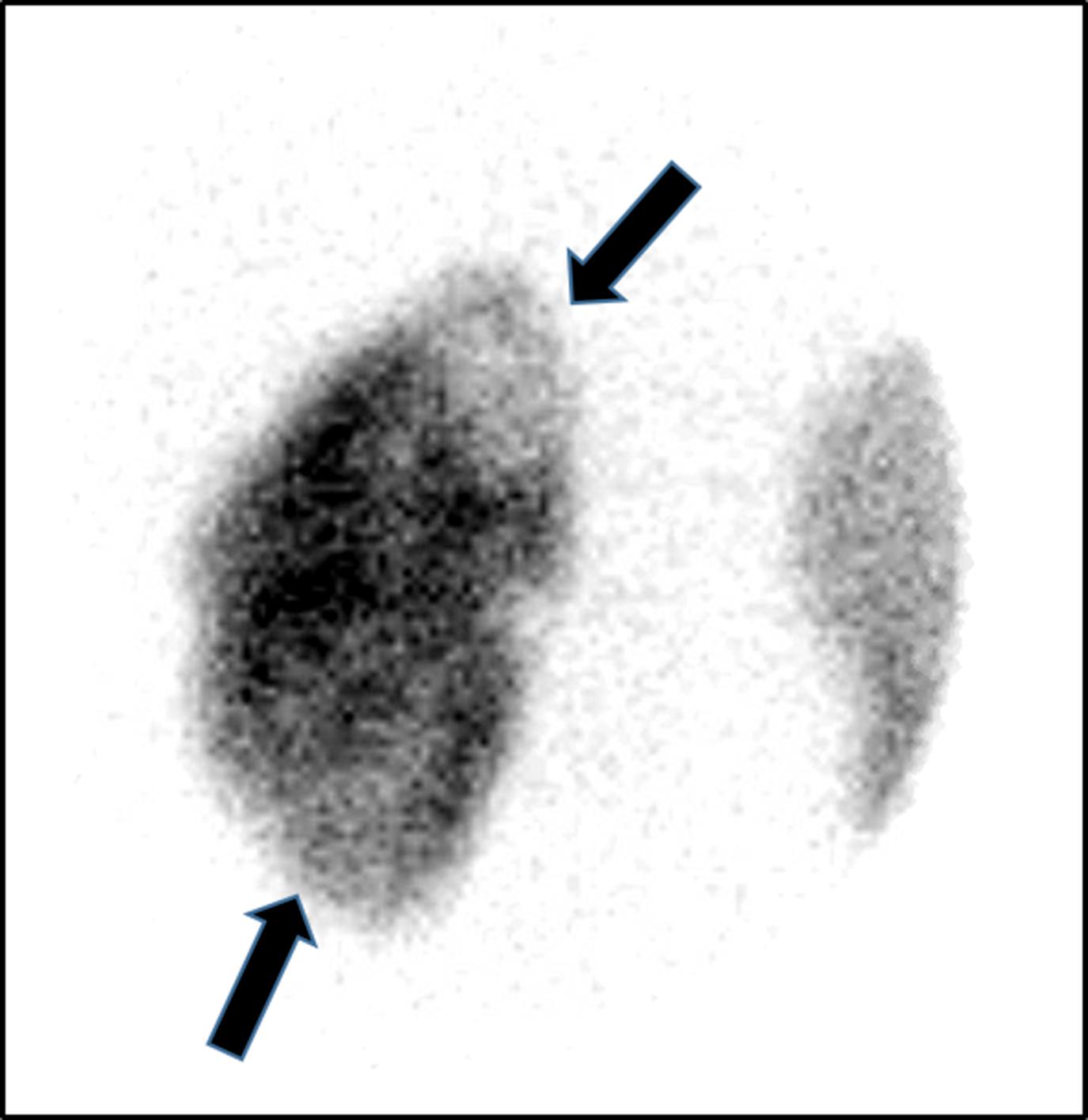
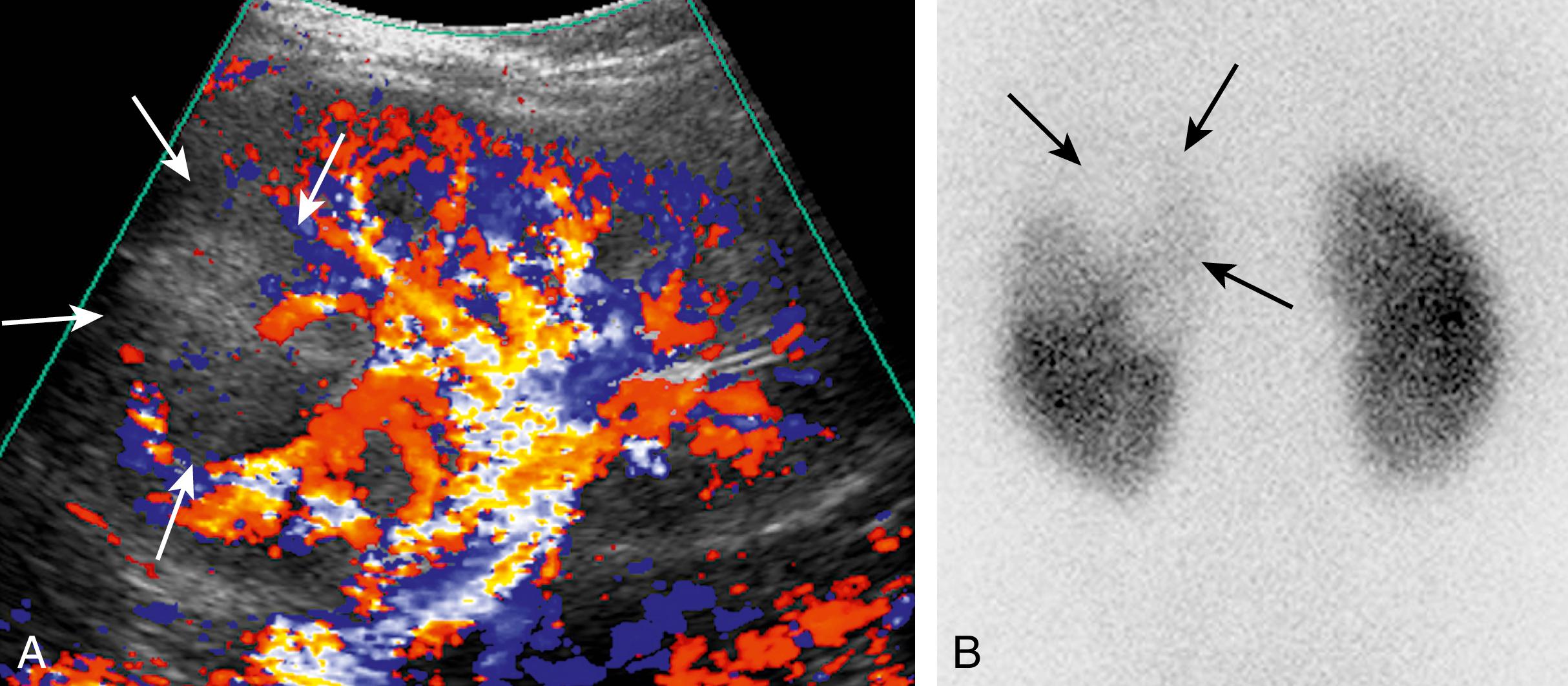
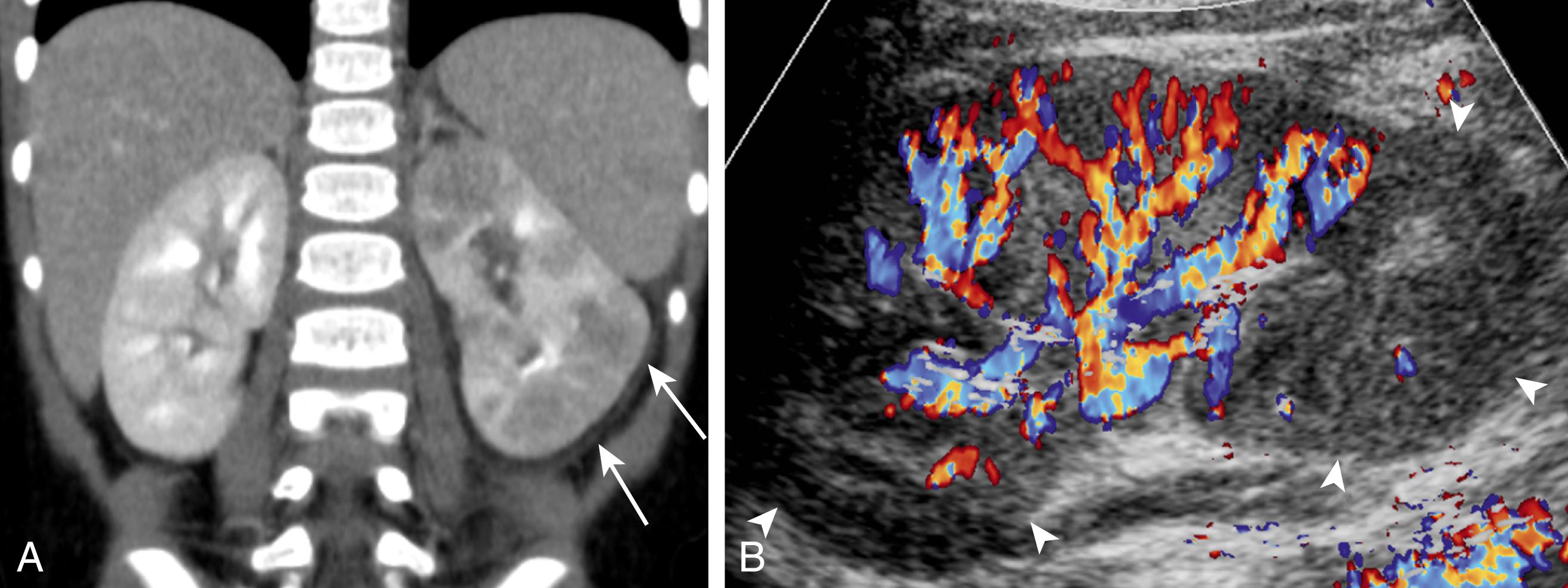
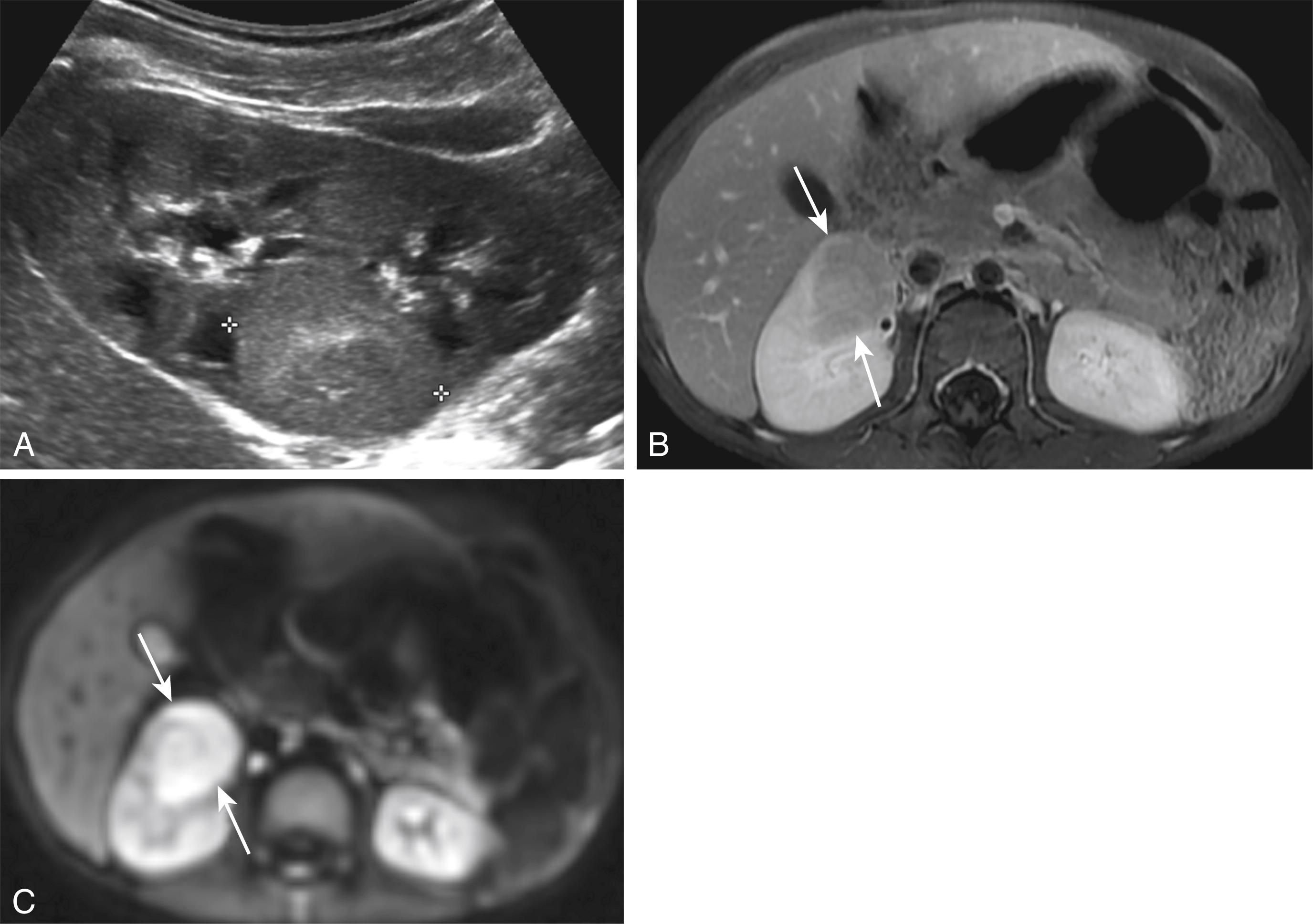
Chronic pyelonephritis is defined as the loss of renal parenchyma resulting from previous bacterial infection. It is synonymous with renal scarring. Normally, the renal cortical thickness should be symmetric and equal within the upper, mid, and lower portions of the kidneys. The loss of renal cortical thickness as seen by ultrasound, most commonly at the renal poles, is suggestive of the diagnosis ( Fig. 6-6 ). This should not be confused with fetal lobulation, also known as an interrenicular septum ( Fig. 6-7 (old Fig. 6-7 )), a normal variant. The scarring of pyelonephritis appears as indentations of the renal contour that overlie the renal pyramids, whereas in fetal lobulation the indentations overlie the columns of Bertin between renal pyramids ( Fig. 6-7 (old Fig. 6-7 )).
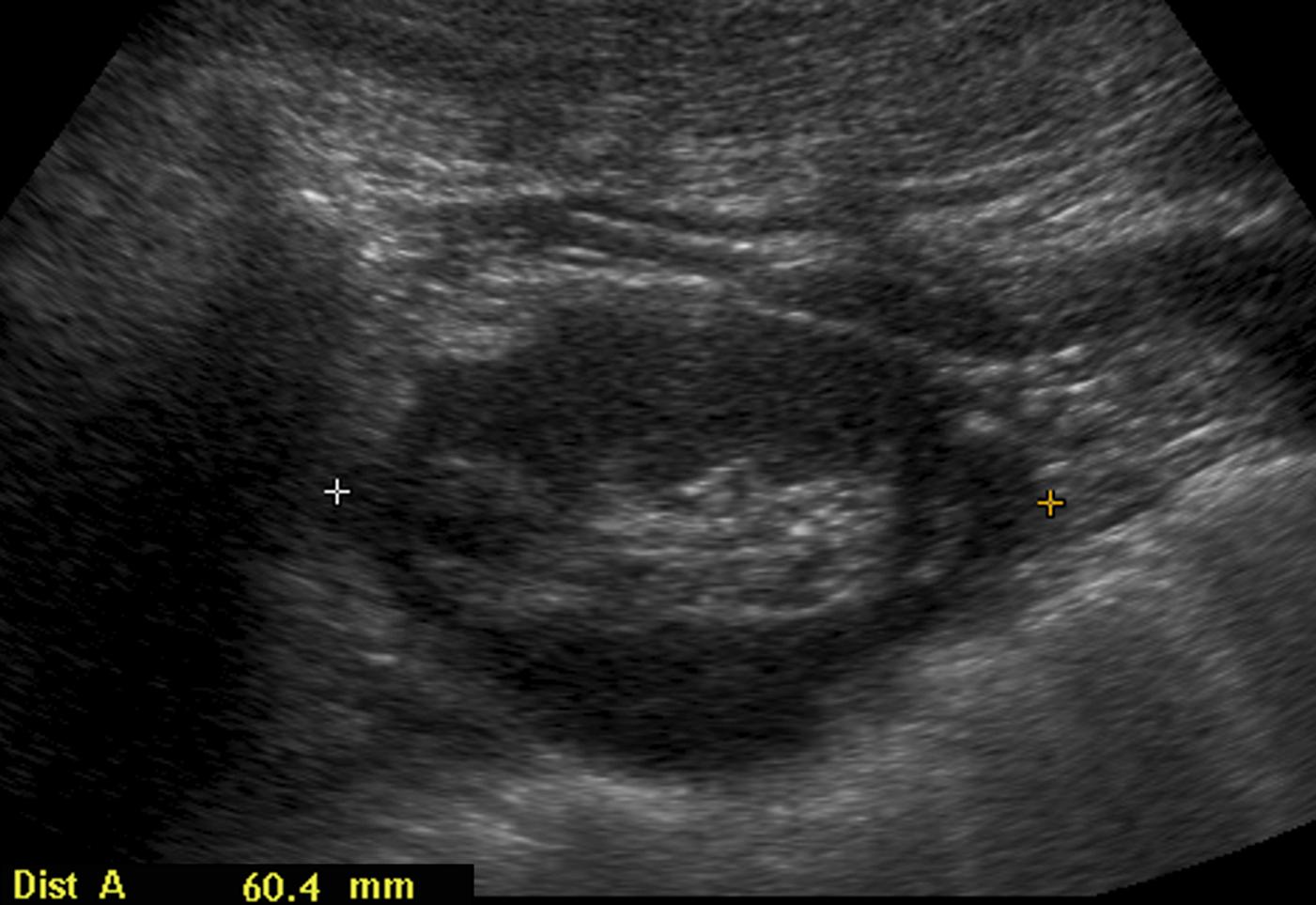

Prenatal hydronephrosis is diagnosed in 1%–2% of all pregnancies. Many of these cases require further work-up with postnatal imaging, usually ultrasound. The first postnatal US should be done within the first month of life but not sooner than 48 h after birth because of the physiologic dehydration that occurs during this period that may result in underestimation of the degree of urinary tract dilation. Exceptions to this delay include patients with oligohydramnios, urethral obstruction, bilateral high-grade dilation, and concerns about parental noncompliance that may result in losing the patient to follow-up.
A multidisciplinary consensus group has recently proposed to standardize the terminology, grading, and follow-up protocols in these children in order to better correlate current management with decrease in the risk of postnatal uropathy and eventually improve the clinical outcomes. This consensus group proposes to use the term “urinary tract dilation” as a substitute for “hydronephrosis” as the latter can have different meanings to different practitioners. The severity of the urinary tract dilation is graded using six categories of US findings: measurement of the anteroposterior dimension of the renal pelvis (<10 mm is normal), presence and type of calyceal dilation, thickness of the renal parenchyma, appearance of the renal parenchyma, persistent dilation of ureter, and appearance of the bladder. Using these categories, patients are stratified in three risk groups and each group has follow-up recommendations regarding the timing of the second postnatal ultrasound, need for VCUG and functional nuclear medicine scan, and indication for prophylactic antibiotics.
In about 50%–70% of prenatal urinary tract dilation cases, no specific pathology is found and the dilation is usually a transient finding without clinical repercussion. However, in approximately 30%–50% of cases, there is underlying pathology with a broad spectrum of causes that in a small group results in significant postnatal morbidity and even mortality. More common specific causes include VUR, ureteropelvic junction (UPJ) obstruction, ureterovesical junction obstruction/megaureter, and posterior urethral valves.
VUR is defined as retrograde flow of urine from the bladder into the ureter. It can be a primary abnormality related to immaturity or maldevelopment of the ureterovesical junction. Normally, the ureter enters the ureterovesical junction in an oblique course such that the intramural ureter traverses the bladder wall for an adequate length to create a passive antireflux valve. In VUR, the angle of entrance of the ureter is abnormal and the intramural tunnel is short, allowing reflux. VUR occurs in less than 0.5% of asymptomatic children but is present in as much as 50% of children with UTI. There is an increased incidence of VUR in siblings of children with VUR and in children of parents who had VUR. VUR can also be secondary to other urinary anomalies including those that can cause bladder outlet obstruction, especially posterior urethral valves, or others such as neurogenic bladder, bladder dyssynergia and dysfunctional voiding, and prune-belly syndrome.
The importance of VUR is its association with renal parenchymal scarring. VUR is present in almost all children with severe renal scarring. In addition, a direct correlation between the grade of VUR and prevalence of scarring has been demonstrated. Other complications associated with VUR include acute pyelonephritis, interference with the normal growth of the kidney, and development of arterial hypertension.
Conventional US has a limited role in the diagnosis of VUR as it is frequently normal in cases of low-grade VUR and sometimes also in cases of high-grade VUR. On the other hand, mild degree of urinary tract dilation can be commonly found in patients without VUR. US performed after injection of microbubbles before, during, and after micturition is gaining acceptance as a modality to diagnose and grade VUR. However, VCUG remains as the most widely used modality in the assessment of VUR.
The degree of VUR is graded on the basis of several characteristics ( Fig. 6-8 ): the level to which the reflux occurs (ureteral vs. ureteral and collecting system); the degree of dilatation; the calyceal blunting; and papillary impressions. Grade 1 reflux is confined to the ureter. Grade 2 reflux fills the ureter and collecting system, but there is no dilation of the collecting system ( Fig. 6-9 ). Grade 3 reflux is associated with dilation of the collecting system with mild calyceal blunting. Grade 4 reflux is identified by moderate dilation of the collecting system and some tortuosity of the ureter ( Fig. 6-9 ). Grade 5 reflux is defined by the presence of a very tortuous dilated ureter with marked dilation of the ureter and collecting system. Both grade 4 and 5 reflux can be associated with intrarenal reflux.
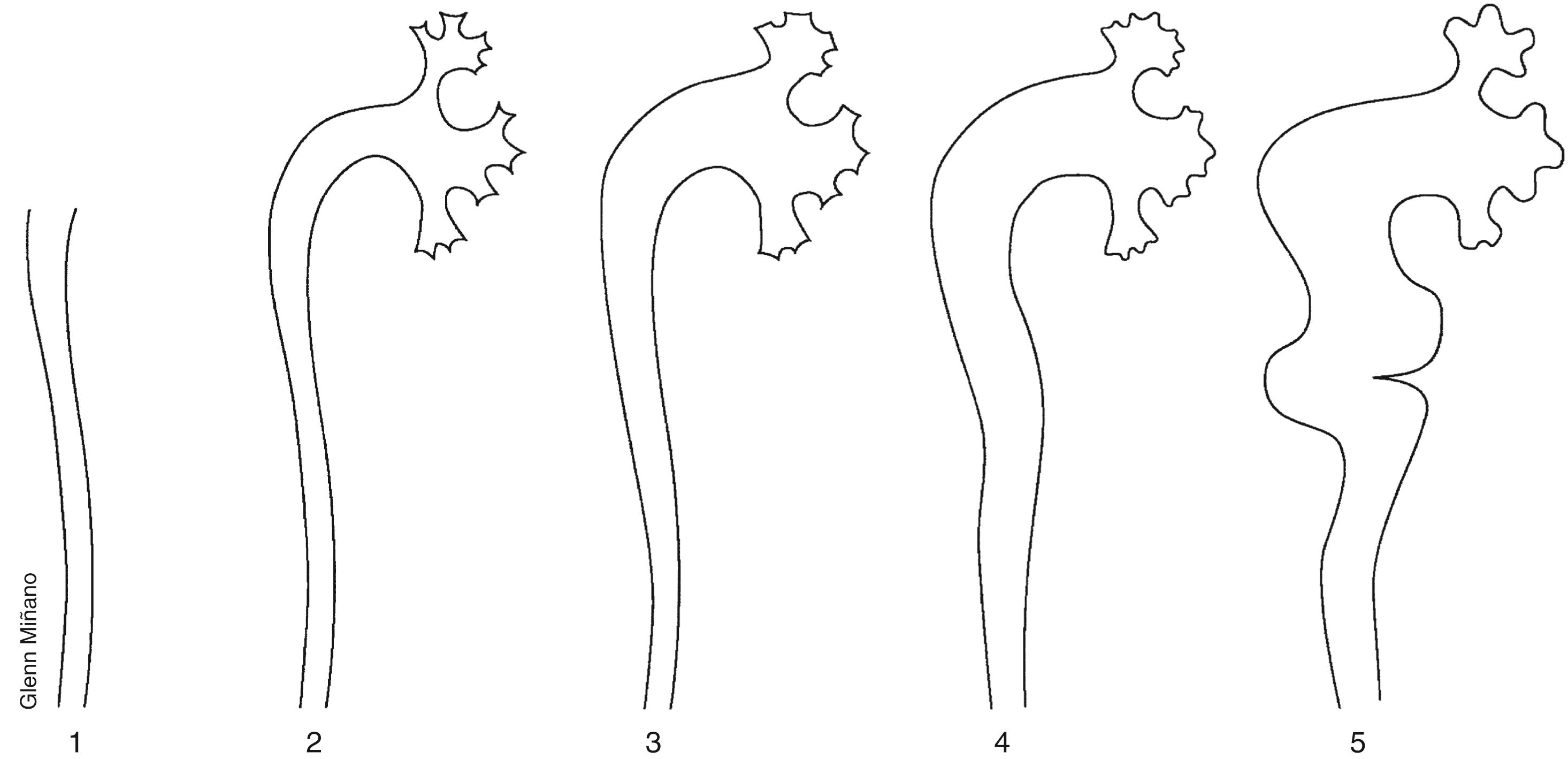
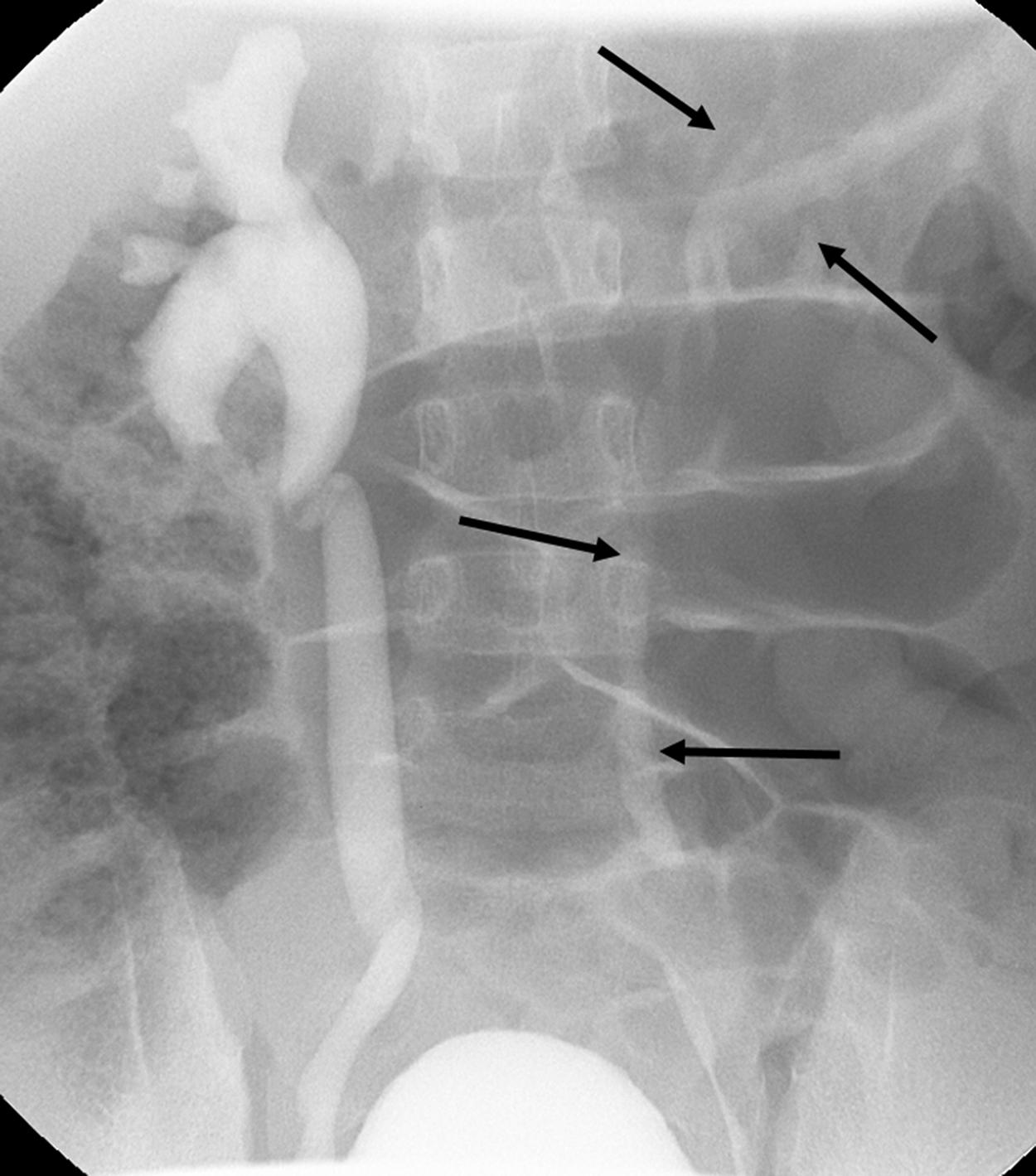
Most cases of low-grade VUR resolve spontaneously by the age of 5–6 years unless there is an underlying anatomic abnormality, and in these children, treatment is usually with prophylactic antibiotics alone, although this is controversial. Antibiotic therapy is discontinued when the reflux has resolved. Surgical reimplantation of the ureter or submucosal injection of a bulking agent below the ureteral orifice (minimally invasive endoscopic treatment) is considered when the degree of VUR is severe, if there is evidence of renal scarring, if the VUR has not resolved over a reasonable time, or if breakthrough infections occur frequently. After periureteral injection, US will show an echogenic mound in the bladder wall in the region of the treated ureteral orifice ( Fig. 6-10 ).
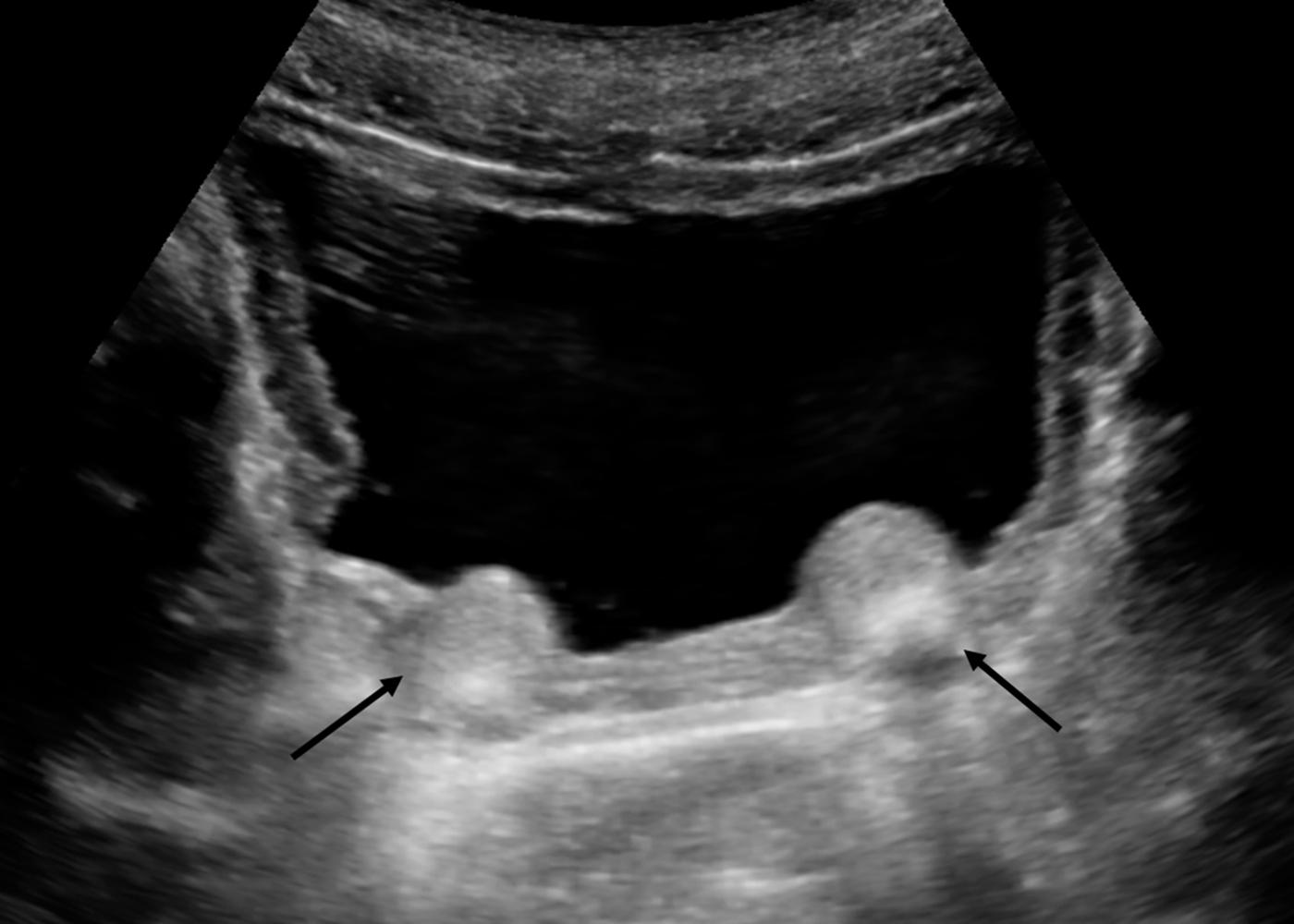
UPJ obstruction is defined as an obstruction of the flow of urine from the renal pelvis into the proximal ureter. It is the most common congenital obstruction of the urinary tract and it is associated with an increased incidence of other congenital urinary tract anomalies including VUR and renal duplication, among others. Males are more often affected than females, and there is a predilection for the left side. In addition, UPJ obstruction may be bilateral in approximately 10% of cases, but the severity may be asymmetric. The cause of most UPJ obstructions is intrinsic narrowing at the UPJ. However, extrinsic compression secondary to anomalous vessels is also occasionally identified.
On US, there is dilation of the renal collecting system without dilation of the ureter ( Fig. 6-11 ). The degree of dilation may be severe and associated with thinning of the renal parenchyma. Renal scintigraphy using 99 m Tc-MAG3 with diuretic (furosemide) challenge is often used to evaluate the severity of the UPJ obstruction. Most neonates with UPJ obstruction are characteristically asymptomatic, and the condition is usually diagnosed following postnatal US evaluation of prenatal hydronephrosis. MRU is increasingly used for better assessment of UPJ anatomy and detection of crossing vessels as well as for estimation of renal function. Children with UPJ obstruction and other congenital anomalies are predisposed to renal injury even by minor abdominal trauma ( Fig. 6-12 ). Mild and moderate UPJ obstructions are usually managed conservatively as they tend to resolve spontaneously. However, most severe UPJ obstructions are treated surgically, with open pyeloplasty being increasingly replaced by robotic or laparoscopic pyeloplasty, with similar rates of success.
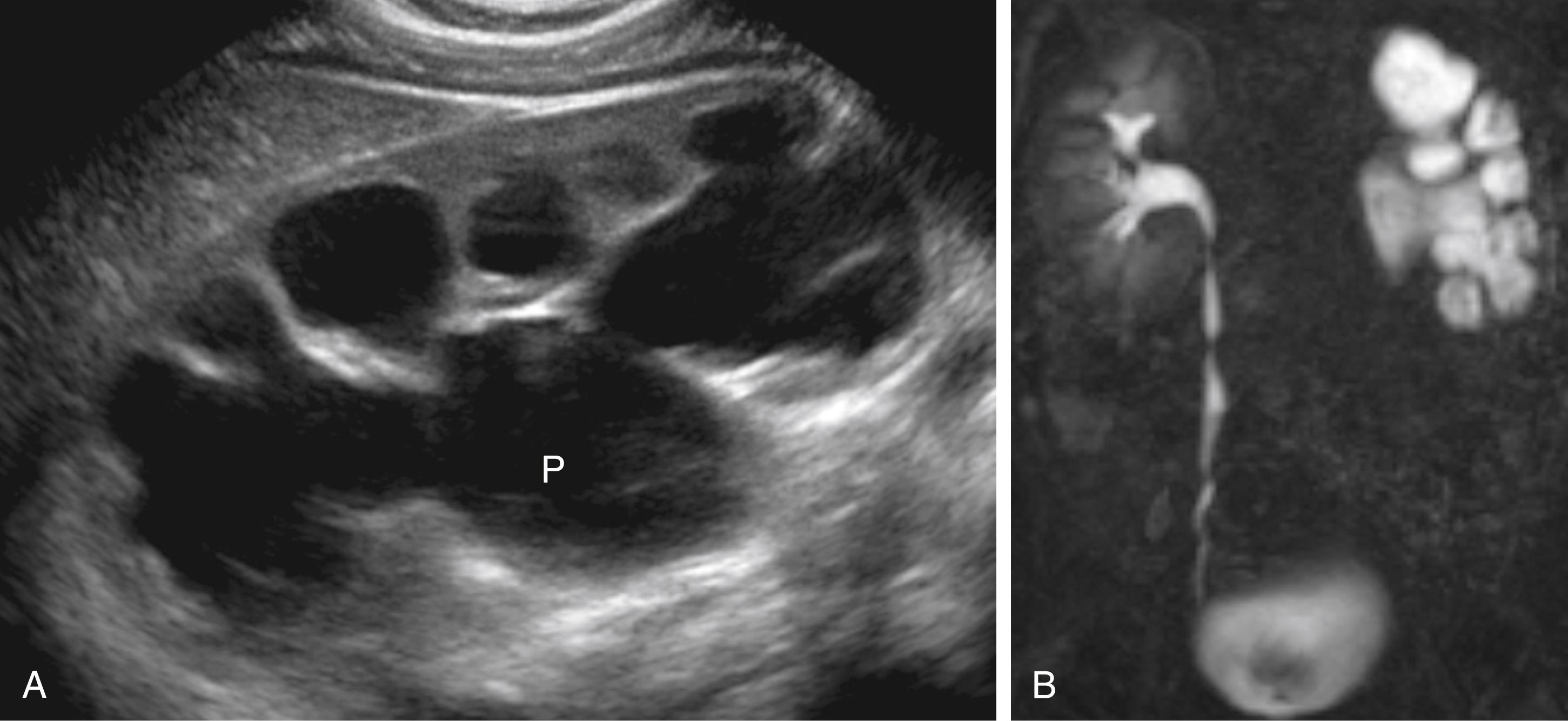
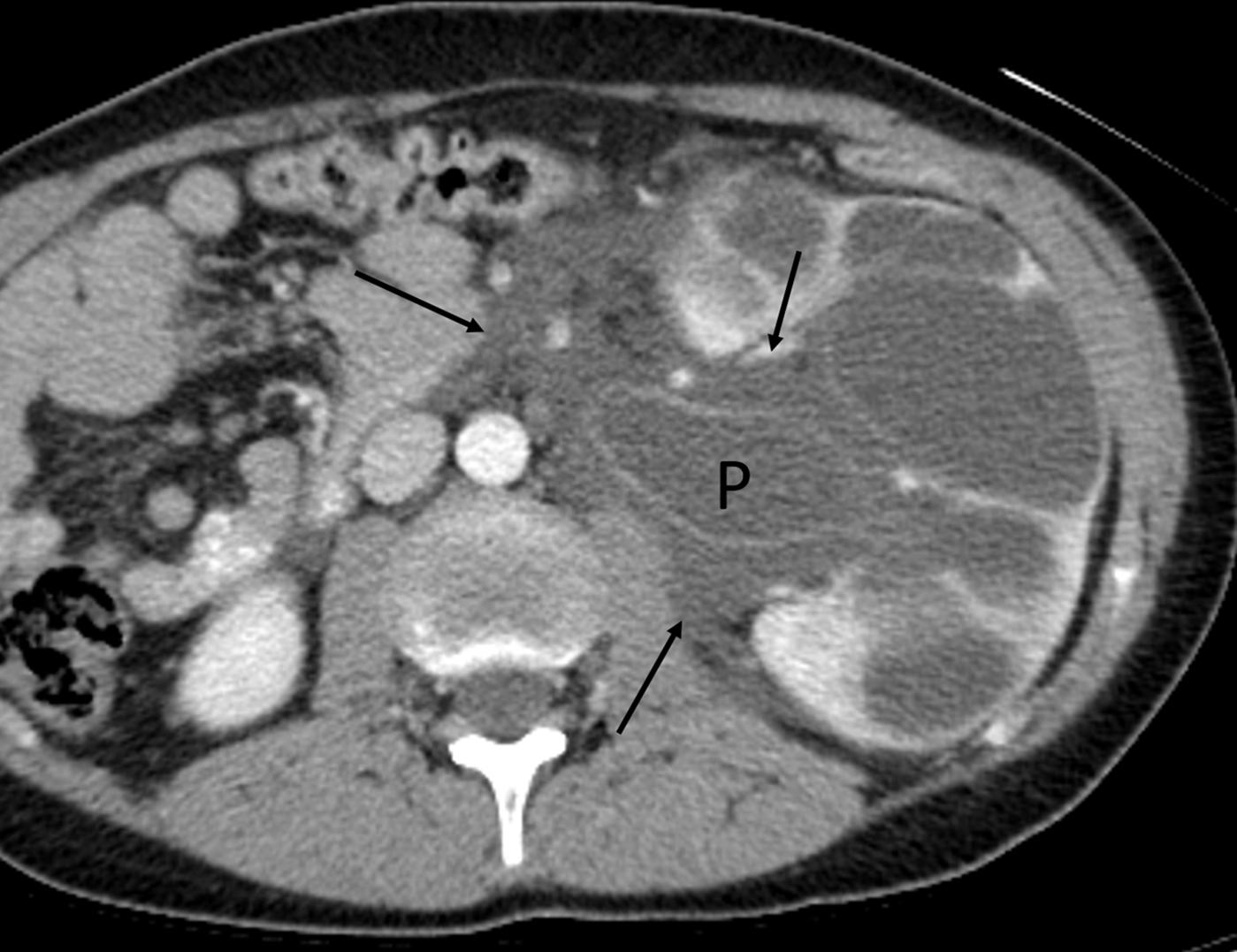
Megaureter is a descriptive term that indicates the presence of a dilated ureter with or without associated pelvicalyceal dilation. It is called primary if it is caused by an intrinsic ureteral anomaly and secondary if the cause is not ureteral. Four main types of primary megaureter have been described. These types include (1) obstructive megaureter, in which there is an aperistaltic segment of the distal ureter that results in a relative obstruction ( Fig. 6-13 ). The normal more proximal ureter dilates as a consequence of the relative obstruction. It is more common on the left and in boys. Children affected with primary megaureter may present with infection or be diagnosed prenatally. US shows dilation of the ureter (>7–8 mm) above the aperistaltic segment and varying degrees of dilation of the collecting system. Other types include (2) refluxing megaureter, which is the result of VUR; (3) refluxing megaureter with obstruction, which is rare and often related to ectopic insertion of the ureter in the bladder neck; and (4) nonrefluxing, nonobstructed megaureter, which is the most common cause of a neonatal megaureter. In this latter type, no VUR or focal stenosis at the ureterovesical junction can be demonstrated. Causes of secondary megaureter include megacystis–megaureter syndrome, prune-belly syndrome, neurogenic bladder, and posterior urethral valves. Imaging algorithms are aimed to define the roles of VUR or obstruction in the presence of a megaureter.
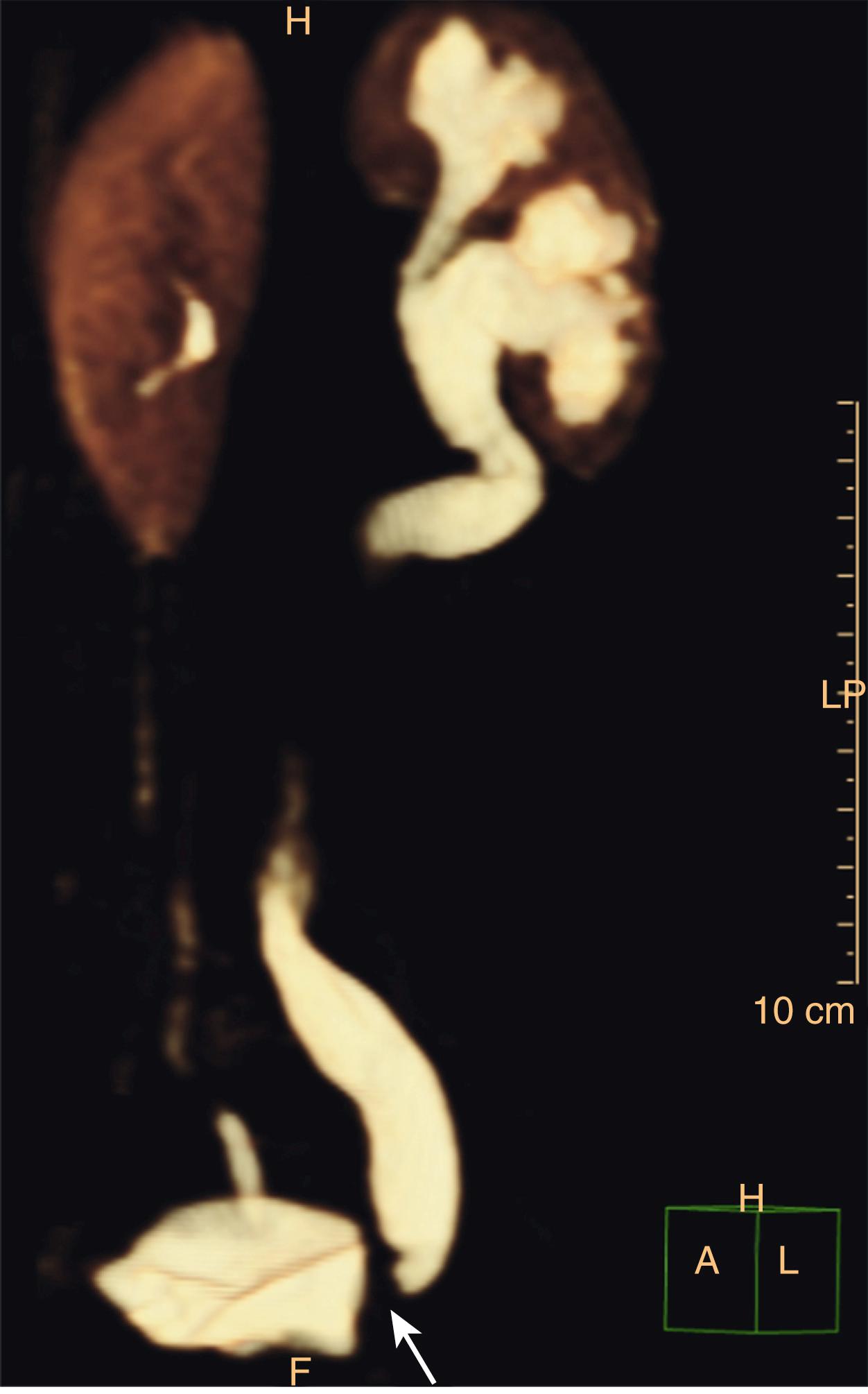
A ureterocele is defined as a cystic dilatation of the distal ureter. The dilated portion of the ureter lies between the mucosal and muscular layers of the bladder. The ureteral orifice is usually stenotic or obstructed. Ureteroceles are defined as simple or orthotopic when they are positioned at the expected orifice of the ureter at the lateral aspect of the trigone. Ureteroceles are defined as ectopic when they are associated with an ectopic insertion of the ureter. Ectopic ureteroceles can be quite large and are almost always associated with a duplicated collecting system ( Figs. 6-14 and 6-15 ). The ureter from the upper pole moiety is the one associated with the ureterocele. On VCUG, ureteroceles appear as round, well-defined filling defect, best visualized on early filling views ( Fig. 6-14 ). Ureteroceles may be compressed and not visualized when the bladder is distended by contrast ( Fig. 6-14 ). Sometimes the ureteroceles can evert and appear as diverticula. On ultrasound, a ureterocele is seen as a round, anechoic intravesical cystic structure that can be connected to the distal ureter ( Fig. 6-15 ). There can be varying degrees of dilatation of that ureter and the upper pole moiety collecting system, sometimes quite severe with associated marked parenchymal thinning ( Fig. 6-15 ).
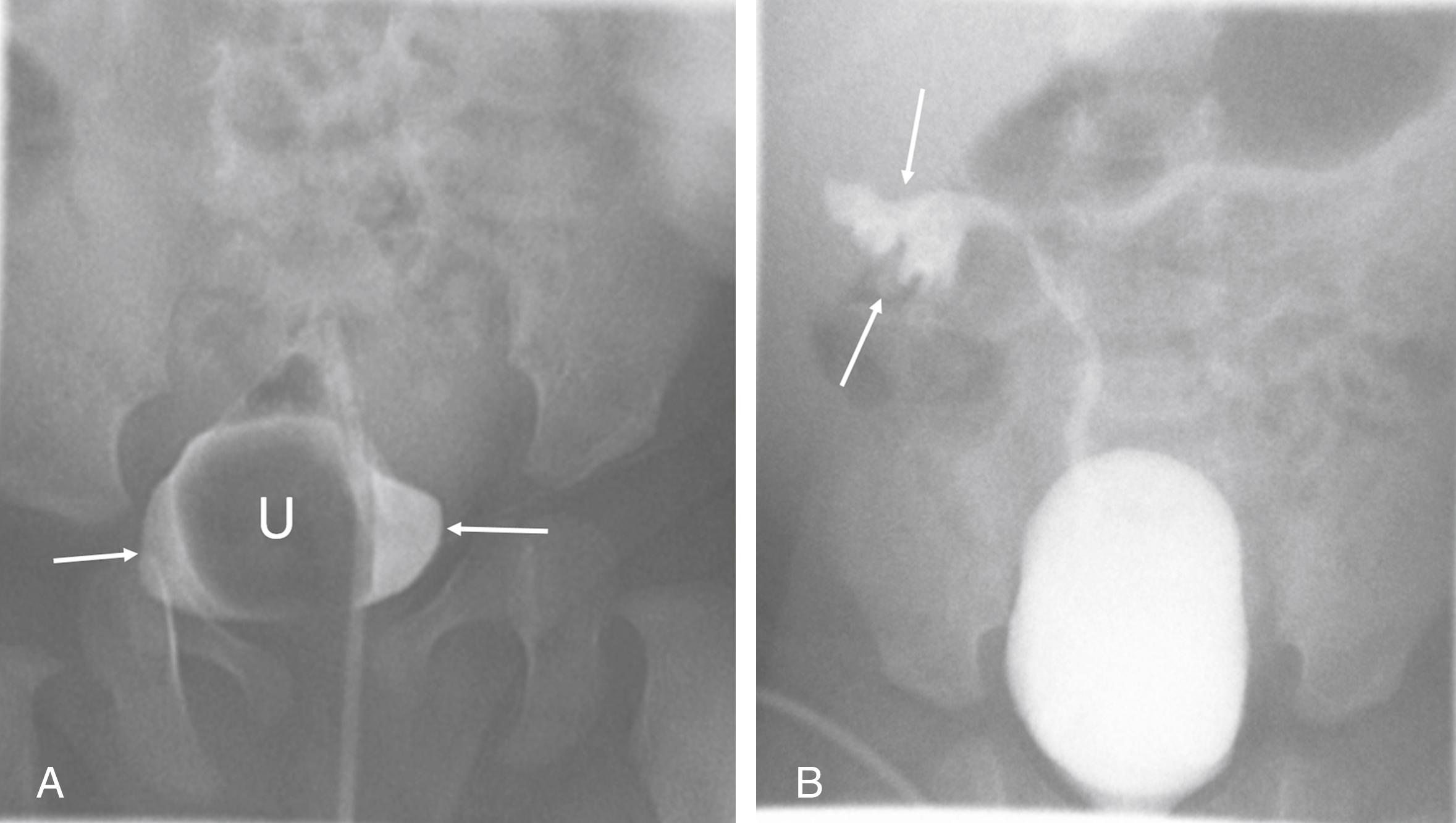
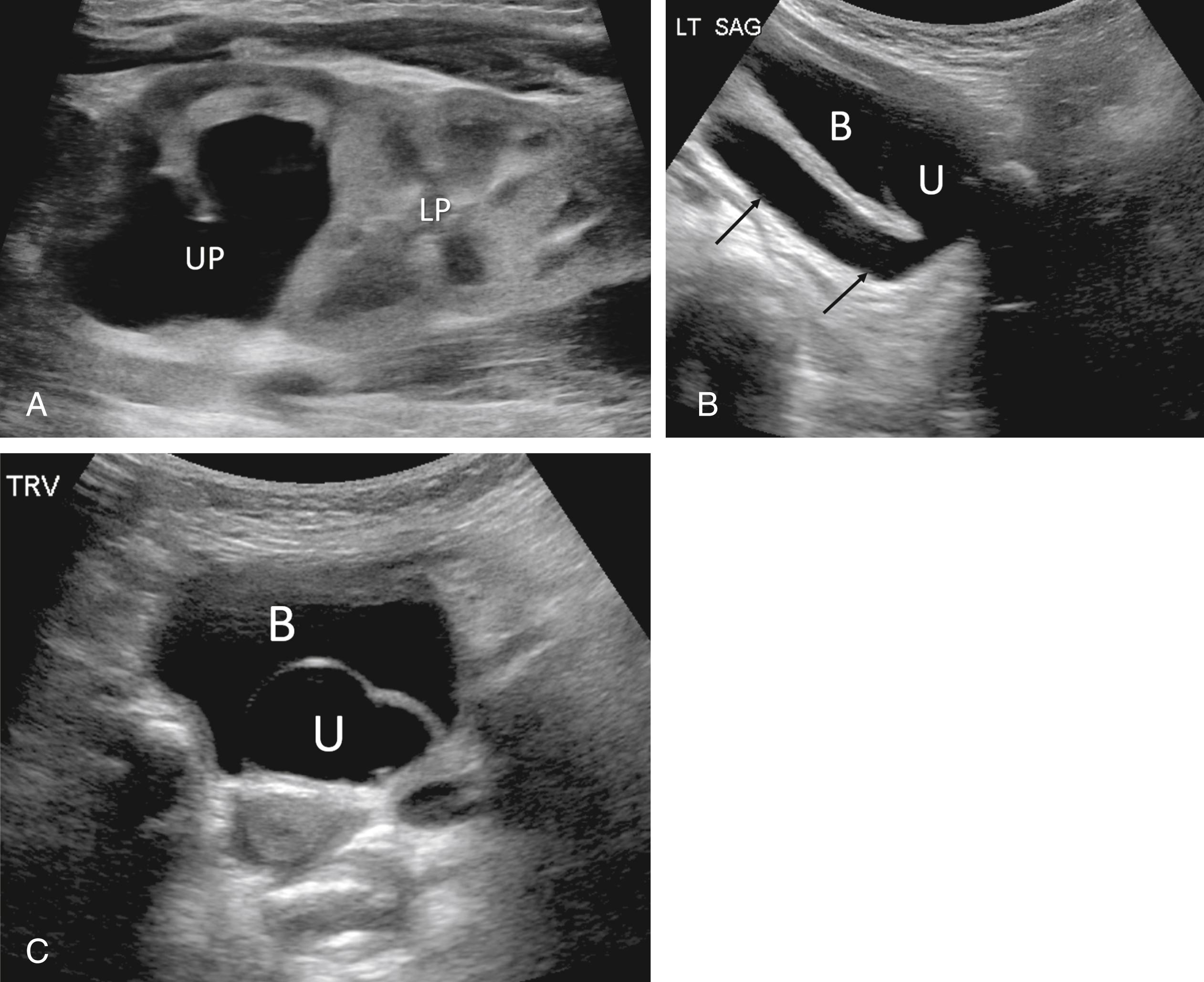
Posterior urethral valves are the most common cause of urethral obstruction in male infants. They represent abnormal mucosal folds between the urethral wall and the distal end of the verumontanum. They are identified most commonly in infancy but can be diagnosed in older children. The high back pressure can damage the kidneys and result in renal failure. Affected children can be diagnosed prenatally and present with renal failure or with UTI.
Typical US features include a thick-walled bladder with associated bilateral dilatation of the renal collecting systems and ureters ( Fig. 6-16 ). Occasionally, a dilated posterior urethra can be identified inferior to the bladder. Perinephric fluid collections representing urinomas secondary to calyceal rupture can also be seen ( Fig. 6-16 ). On VCUG, the posterior urethra is often very dilated ( Fig. 6-16 ). The actual valve itself may be difficult to visualize, but it can appear as a membrane-like obstruction; however, its presence is more commonly recognized by the abrupt change of caliber at the transition from posterior to anterior urethra. The bladder is trabeculated and may have pseudodiverticula. VUR is present in approximately 50% of patients with posterior urethral valves.

Anything that relieves the increased pressure within the urinary system of patients with posterior urethral valves protects the patients from developing renal failure and is associated with a better prognosis by lowering the urinary back pressure on the renal parenchyma and decreasing the potential for renal damage. Such entities include unilateral VUR (with protection of the kidney contralateral to the reflux), large bladder diverticula, or development of intrauterine urinary ascites. The spectrum of clinical severity is wide, and the prognosis is typically poor in cases of moderate-to-severe upper tract dilatation before 20 weeks of gestation. On the contrary, the outcome is generally favorable if the diagnosis of posterior urethral valves is made after the 24th week of gestation. It is the potential of posterior urethral valves that makes obtaining an image of the urethra during voiding a vital part of every VCUG performed on boys.
Become a Clinical Tree membership for Full access and enjoy Unlimited articles
If you are a member. Log in here